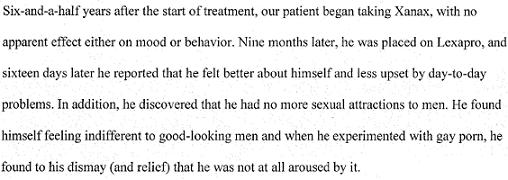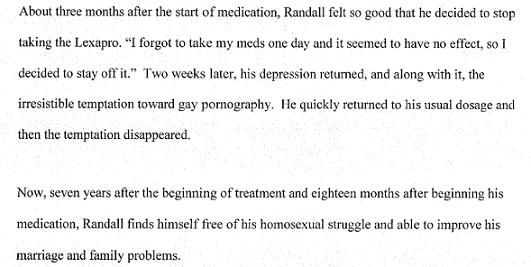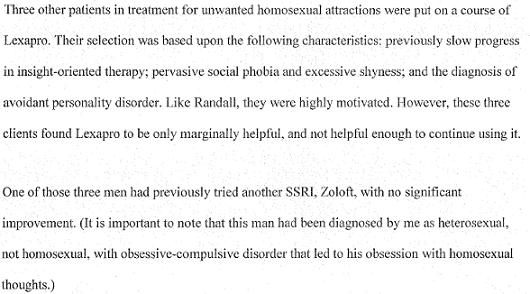Historically, the National Association for the Research and Therapy (NARTH) has considered Exodus an ally in the social discussion of sexual orientation change efforts. Until recently, Exodus sold reparative therapy books in their bookstore but recently removed them. Also, Alan Chambers recently told an audience at the Gay Christian Network conference that
The majority of people that I have met, and I would say the majority meaning 99.9% of them have not experienced a change in their orientation or have gotten to a place where they could say that they could never be tempted or are not tempted in some way or experience some level of same-sex attraction.
I asked Alan Chambers about the reason for the removal of the reparative therapy books and he told me that Exodus wants to be clear that Christian discipleship is how they want to be known. He also said that he has respect for reparative therapy observations but added
The reason I removed RT books from Exodus Books is because I don’t agree with using this research as a means to say that “this” is how homosexuality always develops, “this” is the primary means in which to deal with it and this is “the” outcome you can expect. Too, Exodus, as a whole, is not a scientific or psychological organization…we are a discipleship ministry and that is where I think our strength is and energy should be focused.
Apparently, these developments are troubling to NARTH leaders. One of them, David Pickup, recently penned an article at the Anglican Mainstream in defense of reparative therapy. He wrote the article in direct response to the comments by Alan Chambers, noted above. Pickup writes:
Authentic Reparative Therapy really works. It works to help men change their sexual orientation, naturally dissipate their homoerotic feelings, and maximize their heterosexual potential.
However, there is evidence from the Exodus ministry that could be signaling an unawareness of this important message. Exodus has indicated a significant change in their views and policies as evidenced by the remarks of Exodus President Alan Chambers at the Gay Christian Network Conference last week. The official commentary on the peter-ould.net website has brought this to our attention. I believe their interpretation of Alan Chamber’s remarks is correct.
Chambers’ remarks essentially indicate that:
1. Exodus will no longer indicate or specifically claim that change from Gay to 100% straight is possible for anyone except for a few rare cases.
2. Exodus has apologized and will continue to do so for making these unrealistic claims, which they now believe have contributed toward misinformation, hurtfulness and homophobia.
3. Exodus will work to achieve a deeper understanding of the truth of homosexuality, which will allow them to minister more effectively and compassionately to those dealing with homosexuality.
Pickup then says something that will leave Exodus and NARTH watchers in disbelief.
In my experience, Exodus has, quite unintentionally for the last 20 years, failed to understand and effectively deal with the actual root causes of homosexuality and what leads to authentic change. I laud their willingness to admit their naiveté’, but I do not see anything so far that indicates they now truly understand the psychological, developmentally-based causes of homosexuality or what produces real change.
According to Pickup, not only is Exodus clueless now, they have been for 20 years. I imagine that will come as a shock to those in Exodus who have been given talks straight out the reparative playbook for all those years.
Pickup then offers his slant on why change in orientation should be recognized even if a same-sex attracted person is still same-sex attracted after they say they have changed.
(Parenthetically, let me state it is important that we recognize that just because a man might feel occasional sexual attractions towards men does NOT mean significant and real change has not occurred. Let’s take other challenges common to many people: depression or anxiety for instance. How many people who have successfully dealt with these issues are 100% changed so that they are not susceptible to later feelings of depression or anxiety? Can a therapist guarantee a client will never have those feelings again? Of course not. The same is true for homosexuality. Real change has occurred; however, no apologies should be made if much successful change has occurred even though homosexual feelings occasionally surface.)
I asked Alan Chambers what he meant by saying “99.9” don’t change and he said:
I cannot speak for others who say that temptation or attraction don’t equal orientation. As a layman with regards to that issue, I tend to link them all together and that is where that 99.9%, non-scientifc/anecdotal/experiential statement comes from.
So what does it matter if some same-sex attraction remains? Doesn’t even a little shift deserve the word change attached to it? Alan seems to want to extract himself from this semantic debate by sticking to experience – the vast majority of people he knows retain attractions to the same sex. Pickup wants to explain that away by making sexual attraction analogous to depression or anxiety. Since he sees same-sex attraction as a disorder which stems from childhood wounds, that may work for him, but it won’t work for those who do not see it that way.
One problem here is political. NARTH wants to be able to say SSA people have changed if they experience a reduction in awareness of SSA and perhaps an experience of opposite sex attraction. This is a kind of change and if left in the therapeutic context, I would not quarrel too much with this (except to say that I don’t agree with the kind of techniques often used to push people this way). However, NARTH does not stay in the therapeutic context. They provide support for political groups who want change to mean complete change from gay to straight. Change is such a volatile concept because a modicum of change in the therapeutic setting is then exaggerated in the political and legal settings to argue against same-sex attraction as something intrinsic to the vast majority of people who experience it.
Pickup then lectures Exodus about theology and calls on them to align closer with reparative therapists.
If Chambers and Exodus do want to truly understand the nature of homosexuality, then they should be open to understanding the psychological underpinnings of these issues and start to recommending qualified therapists who are experts at facilitating significant change. If not, then Exodus will fall into deeper controversy than they are in already. They will be reduced to the myopic ministry of simply helping people to deal with their homosexuality through behavioral changes, which, by the way, reflects the American Psychological Association’s belief about Reparative Therapy: that real change is not possible and people may be helped only in the sense of conforming their behavior to reflect their religious beliefs. In short, Exodus will eventually lose even more effectiveness and begin to flounder.
Pickup even claims that reparative therapy is biblical:
Generally, many Exodus members cannot or will not see that Reparative Therapy is reflective of sound biblical principles. They do not understand shame and its role in the etiology of homosexuality. Not knowing this has led to the unintentional shaming of many same-sex attracted individuals for years, and has actually impeded their progress!
So Exodus has been part of the problem all these years?! I have been to several Exodus conferences over the years, and I can say they work hard not to shame people. The only sessions where I heard any shaming take place was in the sessions where reparative therapists told their audiences that the reason they were SSA was because their fathers didn’t love them and their mothers were smother mothers.
After chastising Exodus for shaming people, he engages in the practice by blaming parents and indicting parents and churches for causing the gay.
Many people of faith do not understand the root causes of homosexuality, which are primarily experienced in childhood. If they did understand, they would have to deal with the truth that they may have contributed to the development of their child’s homosexuality by not supplying enough of their emotional and identity formation needs. In general, parents find it very hard to believe how their child’s upbringing could possibly have been so injurious to them since they loved their child so much. However, loving a child and giving the child the love he needs can be two entirely different things. Parents and churches often find this idea to be unbelievable.
All I can say to Pickup’s last sentence there is: if only. If it were true that evangelicals were more skeptical of these ideas, then I believe Exodus would have changed the tune a long time ago. If only evangelicals were more skeptical, we would not be in such a polarized society where Christianity is synonymous with anti-gay.
As if a few anecdotes prove anything, Pickup closes by citing come quotes he says come from satisfied change customers.
“This is really hard work, but when I focus on healing the pain of what I didn’t get from my father or my friends, something in me heals. Then when I get my male needs met, the SSA just goes away by itself.”
“I really feel more attracted to women now. I want to love a woman and have a family.”
“I still have shame issues, and I once in a while feel attracted to a man, but I know how to work on that and feel affirmed by other men now.” I see myself as a man like other men, and the sexual attractions just sort of go away.”
“This affirmation work and the needs I’m getting filled feels a lot better than sex with a guy.”
I have no doubt that healing from real wounds in life can be beneficial emotionally and it can also lead to a better sense of self-control. So when people who are sexually compulsive find some way to understand themselves better, they can resist whatever pressures push them to risky behavior. However, as Alan Chambers recently noted, such benefit infrequently leads to an elimination of same-sex attraction.
Now if four quotes are sufficient for Mr. Pickup, I will end with four statements from my clients about reparative therapy and their experience.
Our therapist told us after taking our money that there was nothing he could do for us because our family didn’t fit the typical family for a homosexual. He even said that our son would grow out of it because we didn’t fit the mold. (He didn’t grow out of it)
I quit going to Journey into Manhood because it just didn’t last. After a weekend, I did lose some of the same-sex attraction but it always came back. I went to a support group, and saw a reparative therapist and it just didn’t change.
When we took our son to the reparative therapist, he told us that same-sex attraction invariably arises due to a broken relationship with me, his father, and a mother who compensates for this. We were devastated; the man said he was describing our family but he was wrong. My son and I have always been close.
You know, I used to want to change my attractions. I felt like a failure when I saw a hot guy. But the last 3 years have been awesome, I don’t have to pretend or anything. I am who I am and that is an SSA man who loves his wife and kids.
I believe it is possible that Pickup’s clients find an adjustment that suits them. However, the mischief starts when reparative therapists generalize those experiences to gay people as a group.
I am sure it obvious that I think Chambers is much more on the right track than Pickup. Although Exodus continues to refer to reparative therapists and there are member ministries that are quite reparative in their approach, I think a move toward honesty about what people can expect is valuable.


